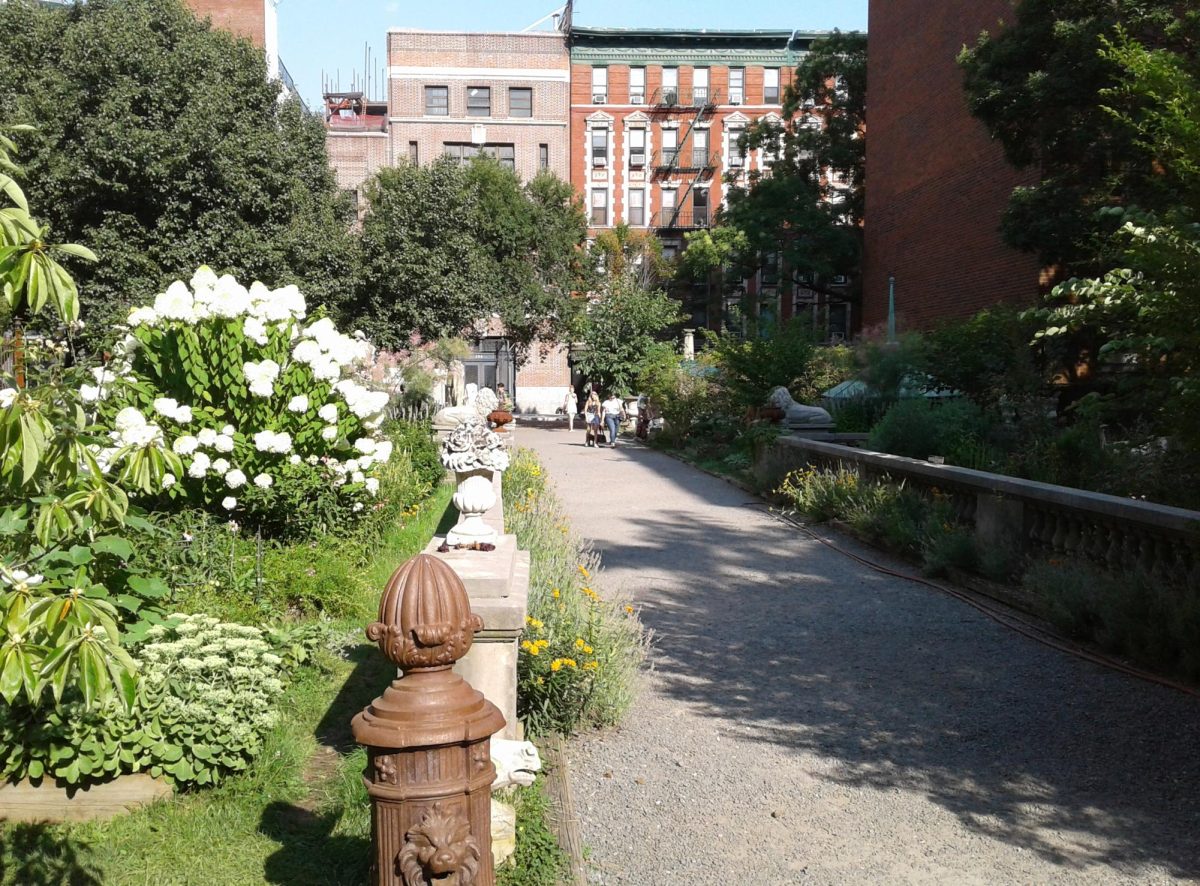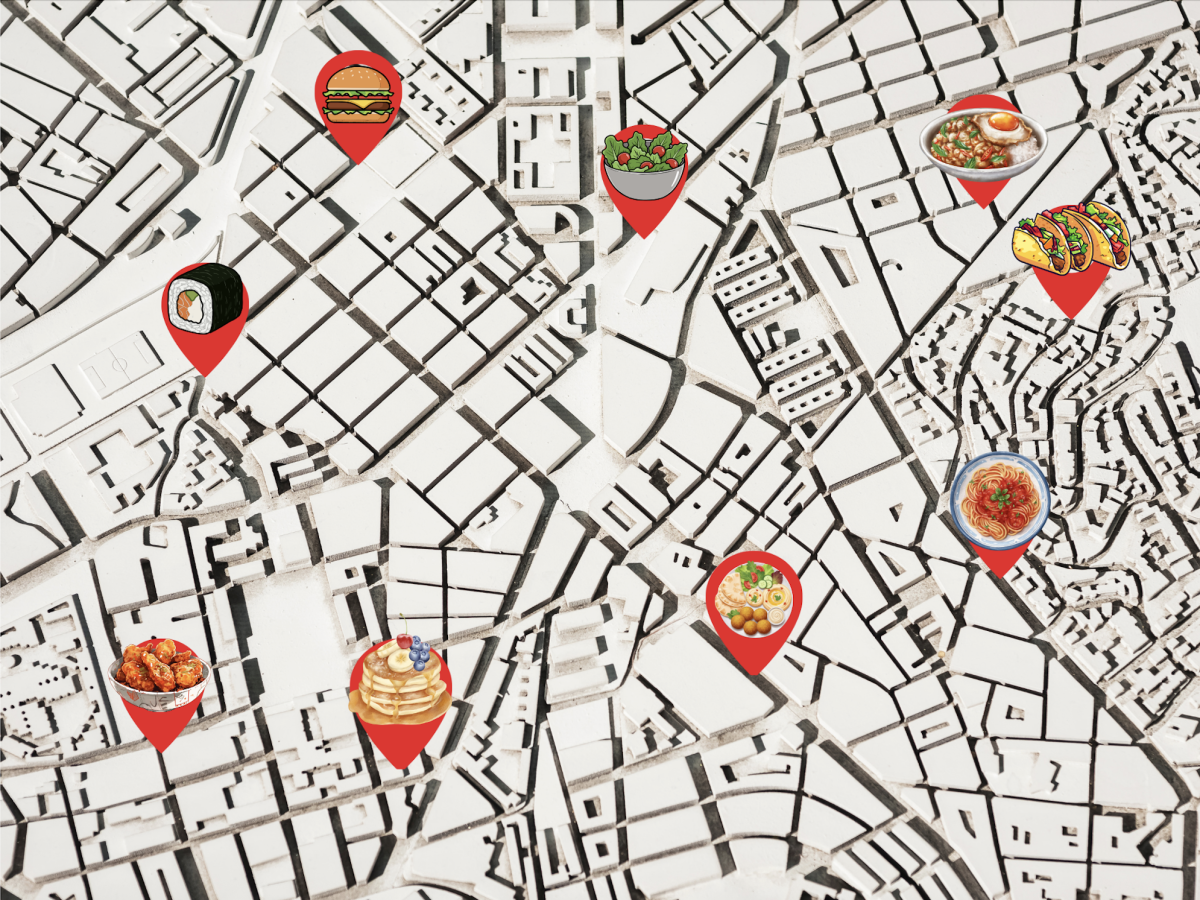In a world overtaken by cars, eradicating the third space is becoming increasingly common. People regularly flock to cities like New York because of its implicit layout to house these third spaces. Despite this variety in our city planning, not even New York City is immune. Parks and unique public spaces are slowly disappearing off the map as the concrete metastasizes.
The Elizabeth Street Garden sits between many buildings, making it a melodious, peaceful alcove. Windchimes hang around the garden, filling it with an angelic song chorus, and the greenery spills over the beaten path that cuts through the small park. There’s an unmistakable edge to the garden’s design—the mark of its long history as a place for art. It’s littered with broken studio lights, metal pieces and ladders as you walk around the garden. There seems to be a pact of silence, a promise to preserve the peace among the people who occupy it. This artsy fringe makes the garden uniquely predisposed to providing deep inspiration in the city. As of Oct. 9, the Elizabeth Street Garden has been served an eviction notice and has less than a week to vacate the property and close the garden.
This site has been a public space for people to enjoy for almost 200 years. The Elizabeth Street Garden has previously existed as an outdoor recreational space and a community hub for those who live in Nolita. First established as a part of a school in the early 1800s, the lot that would one day become the garden stayed resolute as the buildings that used to surround it faded away over time. In 1990, the Elizabeth Street Gallery owner, Allan Revier, leased the space and began filling it with his sculptures and artwork, establishing it into the garden we know today.
For years, the Elizabeth Street Garden has been at risk of dying at the hands of luxury condo establishments. The city favors proposed housing developments and seeks to approve contracting projects to turn the garden into “affordable” luxury condo housing. This is an incredibly dire situation for a multitude of reasons.
The city claims that the proposed projects would create 123 affordable apartments for senior citizens of New York, with 50 apartments reserved for people who are homeless. These apartments and 11,200 square-foot retail and office space would be built below market rate exclusively for Habitat NYC, turning the space into a commercial outlet filled with groceries and coffee. However, this housing will not be affordable forever; it will eventually become housing that could be sold at a market rate.
To save itself, Elizabeth Street Garden has proposed alternate spaces, including abandoned lots and buildings, allowing affordable housing to be achieved without pitting that need against the similarly critical need for a green space–but these proposals have been shot down. Adolfo Carrión Jr., the current City Housing Commissioner, is seemingly unwavering in the community-wide effort to preserve the space.
“They’re not in a position to offer alternative sites. This is a publicly owned site that was intended to be public housing,” Carrión said in response to alternate proposals.
The need for a green space in the area where Elizabeth Street Garden is must be recognized. The garden is one of the only places in Nolita where urban vegetation can be found. It is over a mile from Washington Square Park, the nearest outdoor community center. This makes the district the lowest ratio of public spaces to housing in the city. Destroying the garden would be an irreversibly damaging blow to the community because once that space is gone–it is gone forever. The worst is a lost green space that will never return; the city makes no such effort to destroy possible housing prospects for brand-new green spaces.
“It gives you refuge, even though we live in a big metropolitan area, it provides a reminder of the fact that the Earth is a living breathing vessel,” Ryan Thompson, a model coordinator who’s visited the garden intermittently, said when asked about the importance of green spaces.

A brisk, ten-minute walk downtown from the Elizabeth Street Garden takes you straight into the heart of Chinatown, where protests rage against the Museum of Chinese and America. The protests rally against the museum’s recent acceptance of $3.9 million from the city, assumed to be an alleged exchange for silence about the city’s newest project: a prison tower planned for construction in the middle of the neighborhood. The construction of this new prison tower is wall-to-wall with a low-income senior living center that is now in complete disrepair. Residents of this senior center have had to close their windows to keep out the dust, and deep cracks have emerged in the shared walls. The city has claimed that the dust poses no risk and causes no respiratory illness. However, outside medical sources have said seniors are more at risk for respiratory issues despite the dust’s safety. The clinic and the daycare that occupied it have garnered water damage due to the structural un-soundness of the building.
Sherman Eng, president of the Chung Pak Local Development Corporation and the manager of the senior living center, worries about the damage that may not be visible. According to NYC Health, one in six adults in the city experience tinnitus or some form of hearing loss: “Noise in the community, even at levels that are too low to cause hearing loss, can affect mental and physical health.” According to their site, high blood pressure, fatigue and sleep problems are noted side effects. The noise caused by this demolition process has caused the clinic to close for at least a day due to the severity of the vibrations.
Elizabeth Street Garden, a quiet alcove reprieve, will be torn down to provide an affordable senior living space that will not be affordable forever. All the while, low-income seniors in a senior living home ten minutes away suffocate under a prison construction that misuses taxpayer dollars that could be helping improve their living situations. Furthermore, for the seniors who currently suffer from this noise pollution, an opportunity to escape their situation is revoked from their neighborhood. The city ultimately presents us with a false dichotomy that says we can choose between having a garden or having senior living spaces, but this is a fallacy. We need quiet green spaces to fight against the mental and physical effects of our high level of urbanization.








